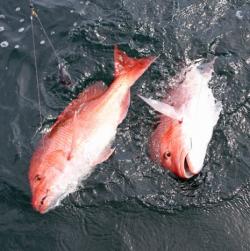Alabama Red Snapper Tally 56 Percent less than Feds Report
EDITOR’s NOTE: Today’s feature, written by Alabama Department of Conservation and Natural Resources’ David Rainer, is yet another example of the continuing conflict between the five states that comprise the shores of the Gulf of Mexico and federal authorities when it comes to managing the Gulf’s fisheries. As you’ll read, the results don’t seem to surprise anyone- but the fight continues.
from The Fishing Wire
As many Alabama offshore anglers will attest, the results from the red snapper catch data is the same old song, second verse.
When the mandatory Red Snapper Reporting System was implemented for the 2014 season, the Alabama Marine Resources Division had a pretty good idea that the catch numbers compiled by the NOAA Fisheries was significantly inflated. The catch data for the 9-day 2014 season reported through Alabama’s “Snapper Check” was 455,522 pounds, while the feds estimated the catch at a whopping 1,227,469 pounds.
The discrepancy between the Alabama red snapper catch data and the federal catch data was recently confirmed with the 2015 numbers.
Keep in mind the 2015 season was different because of sector separation. The private recreational anglers had a 10-day season. The charter boats with a federal reef fish permit were allowed to fish 44 days.
Still, the discrepancy was significant. The federal catch estimate was 2,355,481 pounds. Marine Resources estimated the catch off Alabama at 56 percent less than the federal estimate at 1,045,042. The average-size red snapper landed was more than 8 pounds.
“We continued the Red Snapper Reporting Program for a second year to compare it to the federal MRIP (Marine Recreational Information Program),” said Chris Blankenship, Director of the Alabama Marine Resources Division. “Last year, the results showed that Alabama caught about two-and-a-half times less red snapper than the federal government estimated we caught.
“Where that’s important is the quota is set before the season, and that’s how they determine the number of days for the season. If they are overestimating what’s been landed, our snapper season potentially could have been two-and-a-half times longer if they had used Alabama’s information.”
Anglers who pursue red snapper off the Alabama Gulf Coast have had no problem at all landing nice red snapper during the short seasons (above). Ongoing research on the red snapper population off of Alabama indicates a healthy, vibrant stock (Below). Photos by David Rainer, with permission.Blankenship said even though the parameters changed because of the sector separation, Marine Resources was interested to see if that discrepancy between Alabama numbers and federal numbers would be similar for 2015.
“This year, the federal program estimated there was more than twice the number of red snapper landed than what the Alabama program estimated,” he said.
The reason Blankenship is confident in the Alabama numbers is because of the collection of data through the mandatory Red Snapper Reporting Program and the deployment of Marine Resources personnel to conduct checks at the public boat ramps and marinas, as well as on-the-water checks by enforcement personnel.
“We end up with a correction factor for the ones that were not reported,” he said. “We use that to come up with the final numbers. It’s a much less complicated system than what the federal government uses, and we feel ours is much more accurate.
“We have cameras at the public boat launches; we do vessel counts on how many boats launched during red snapper season. We do this to compare the numbers used by the Alabama reporting program or the MRIP data. What we found was the number of vessels launched very closely corresponds with what the Alabama red snapper program reported. We think that is important validation for our program.”
Blankenship also said the MRIP system is still using a telephone survey of coastal households and extrapolating the data.
“It’s obvious to us when we look at the results from that telephone survey that they are overestimating the amount of effort, the number of fishing trips for the state of Alabama,” Blankenship said. “We are attempting to work with the MRIP team to see what’s causing the difference in data.
“They have been very anxious to see how we have calculated our results from the Alabama Snapper Check, but they have not been as open to show how they come up with their numbers. We’re trying to work through those difficulties. We don’t have anything to hide. We are glad to show how our system works and how we came up with our numbers. It’s not complicated, and we feel it’s very accurate. We want to be able to look under the hood of the MRIP program, and we think it will help them develop a more accurate estimate of the catch, not only in Alabama but nationwide.”
Blankenship said one example of MRIP data that cannot be accurate came from Mississippi.
“When you look at the landings on the NOAA MRIP website for the private recreational season in Mississippi and the federal estimate of their catch, for the 10-day red snapper season in June, the federal MRIP system estimated there was not a single red snapper landed in the state of Mississippi,” Blankenship said. “So in Alabama, the feds estimated we caught more than 2 million pounds of red snapper, and in Mississippi, they estimated they caught zero red snapper during the same time period. This just shows the MRIP system obviously has some flaws.
“That’s why we feel it is so important for the feds to use numbers from Alabama Snapper Check because our numbers are much more accurate.”
The current federal quota for the recreational sector has a 20-percent buffer built in to account for overages. Blankenship said the best way to get rid of that ridiculously large buffer is to have more accurate catch data.
“The best way to get that 20-percent buffer back is to have regional management for either a portion of the quota or true management of red snapper where we do the stock assessment and set the quota,” he said. “We feel like with regional management we can get more days for the private recreational anglers and more days for the charter boats.”
The Gulf of Mexico Fishery Management Council is considering Amendment 39 that would give the five Gulf States regional management of the red snapper fishery.
A public hearing on the amendment was held in Mobile Tuesday night. The full Gulf Council will consider Amendment 39 at its next meeting, which is scheduled for January 25-29, 2016, at Perdido Beach Resort in Orange Beach, Ala.
“The reason Amendment 39 is important is evident in our red snapper reporting numbers,” said Blankenship. “Alabama currently supports Amendment 39 because we feel like we can do a much better job managing this red snapper fishery than is currently being done by the federal government and get our anglers more days to fish.”
Blankenship said Marine Resources is in the process of doing a stock assessment off the coast of Alabama and will hopefully have the results by the end of the year. The early numbers look good.
“The snapper stock seems to be very healthy even after the season,” he said. “Whether we caught a million pounds as Alabama estimates or 2.3 million pounds as the federal government estimates, we’ve been out there doing research since the season ended.
“I can say there is no shortage of legal-size red snapper off the coast of Alabama.”
—DAVID RAINER, Alabama Department of Conservation and Natural Resources

